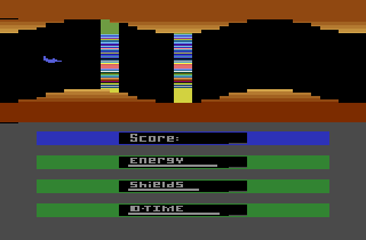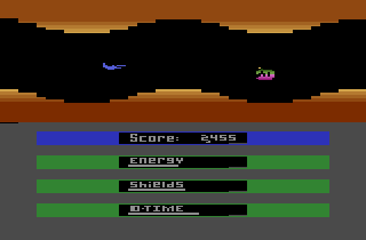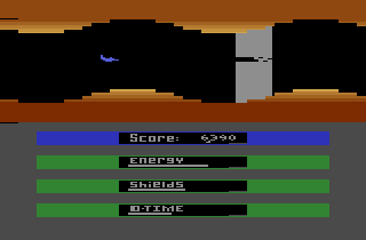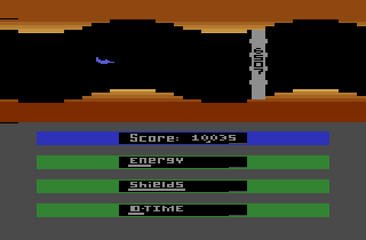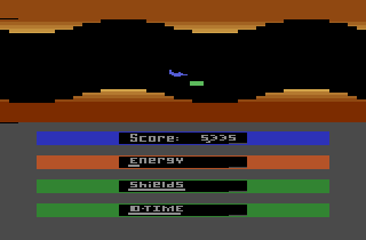|
|
Innerspace
|
Name:
|
Innerspace |
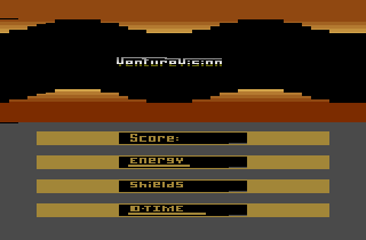 |
| Company: | VentureVision | |
|
Model #:
|
N/A | |
|
Programmer:
|
Dan Oliver | |
| Year: | 1983 | |
|
Released?
|
Yes (see below)
|
|
|
Notes:
|
Released by Imagic as Laser Gates |
Although you wouldn’t know it by the look of it, Innerspace is actually the sequel to VentureVision’s Rescue Terra I. In fact there were actually three games planned for the ‘Terra I Trilogy’, although only the first two were released. The first game, called Rescue Terra I, had you traveling through an onslaught of aliens and asteroids to reach the planet of Terra I. The second game, called Innerspace, has you travel through planetary tunnels to destroy the computer system and return control to the Terra I colonists. The third and final game of the Trilogy, called Solar Defense, had you defending solar reactors around the earth while the Terra I colonists supplied them with Zenbar crystals. Having all three games linked together with a storyline (as thin as it was) was a novel idea at the time, but sadly it was not to be. While VentureVision was able to eke out their first game, they went under before the second or third could be released. Imagic picked up Innerspace and released it as Laser Gates, but Solar Defense remained unreleased. It is unknown if Solar Defense was completed, but it was at least far enough along to be playable and reviewed in Tilt magazine (May/June 1983 issue).
As mentioned above, the goal of Innerspace is to navigate your ship, the Dante Dart, through the caverns of Terra I and destroy the evil Crypic Computer. Thankfully the Crypic Computer comes equipped with a convenient self-destruct mechanism (standard issue with all new evil super computers). Unfortunately you will have to find the four failsafe detonators and destroy them before the self-destruct will activate (there’s always a catch). Just to make matters more interesting, the computer will be throwing the entire might of Terra I’s defense force at you to prevent you from blowing it up.
Innerspace plays much like your standard side scrolling shmup. As you make your way down the narrow tunnels of the planet, you will have to avoid walls, force fields, and a host of nasty ships and guns to make it to the end. Ships come in various shapes, sizes, and behaviors. Some will aim right for you, some will hang back taking shots at you, and some will try to get behind you. Carefully maneuvering around the tunnel while taking well aimed shots at the ships is the key to winning this game. Every now and then you will encounter moving force fields that have a tiny gap that you must maneuver through (which of course is also moving). These moving force fields tend to be the most difficult obstacle to get past so take your time and be careful. You will also encounter solid pillars that you must quickly blast through, but these tend to be more fun than dangerous (just be quick on the trigger or you’ll go splat!).
After a fair bit of time you will eventually reach one of the detonator mechanisms. But before you start blasting away at the four protruding pins, step back and take heed. The pins act like a combination lock, and there is only one correct sequence. The first time you shoot the incorrect pin you will take some damage (quite a bit actually), but if you shoot the same wrong pin twice you will be destroyed! Although the combination changes each game, there’s actually a trick to figuring it out as long as you’re good with binary numbers. You’ll notice that the detonator has a number written on it that starts with 650_ , the correct combination is where the 1’s would be if the number was written in binary (starting from the top). So if the detonator had 6503 written on it the combination would be the top two pins (3 = 0011 in binary). If you’re not good with doing binary on the fly, you might want to write all the combinations down first as you don’t have much time to figure it out during the game.
At the bottom of the screen you’ll notice that there are four gauges: Score, Energy, Shields, and D-Time. Score is self-explanatory, Energy is used up by your ship at a constant rate and must be replenished though energy pods found throughout the tunnel (don’t shoot them!). Shields are diminished each time your hit a wall or get hit by an enemy shot, you start the game with 24 shield units and gain 6 units each time you score 10,000 points. D-Time stands for Detonator Time and indicates how long you have until the detonator explodes, you must rach and destroy the detonator before this gauge expires!
Although Rescue Terra I was considered a excellent game by 2600 standards, it was also noted for being very very difficult. Not only does Innerspace manage to keep the same level of excellence, but it also manages to balance out the difficulty level so that the game is considered to be only very difficult rather than obscenely difficult. Innerspace also has a bit more eye candy going for it in the form up rainbow colored force fields and colorful gauges. It appears that Venturevision took what they learned from making Rescue Terra I and kicked it up a notch when creating Innerspace. One has to wonder how amazing Solar Defense would have been had it been released.
Unfortunately Innerspace was never released, it appears that the collapsing market and industry downturn was too much for the tiny VentureVision to survive. Thankfully the game was saved from the abyss by Imagic who decided to release it as Laser Gates (a reference to the moving force fields found in the game). The game is exactly the same as Innerspace with the exception of a new name and copyright on the title screen. Imagic also managed to program innerspace on the Atari 8-bit computers, but it was only released on a very rare compilation package called Imagic 1-2-3. It is believed that the 8-bit version is an original Imagic port and not based on an unknown VentureVision 8-bit proto.
| Version | Cart Text | Description |
| ?????? | N/A | Final Version |

